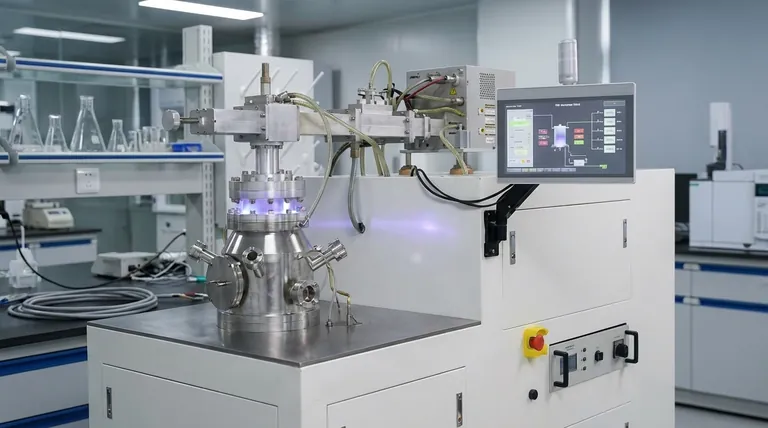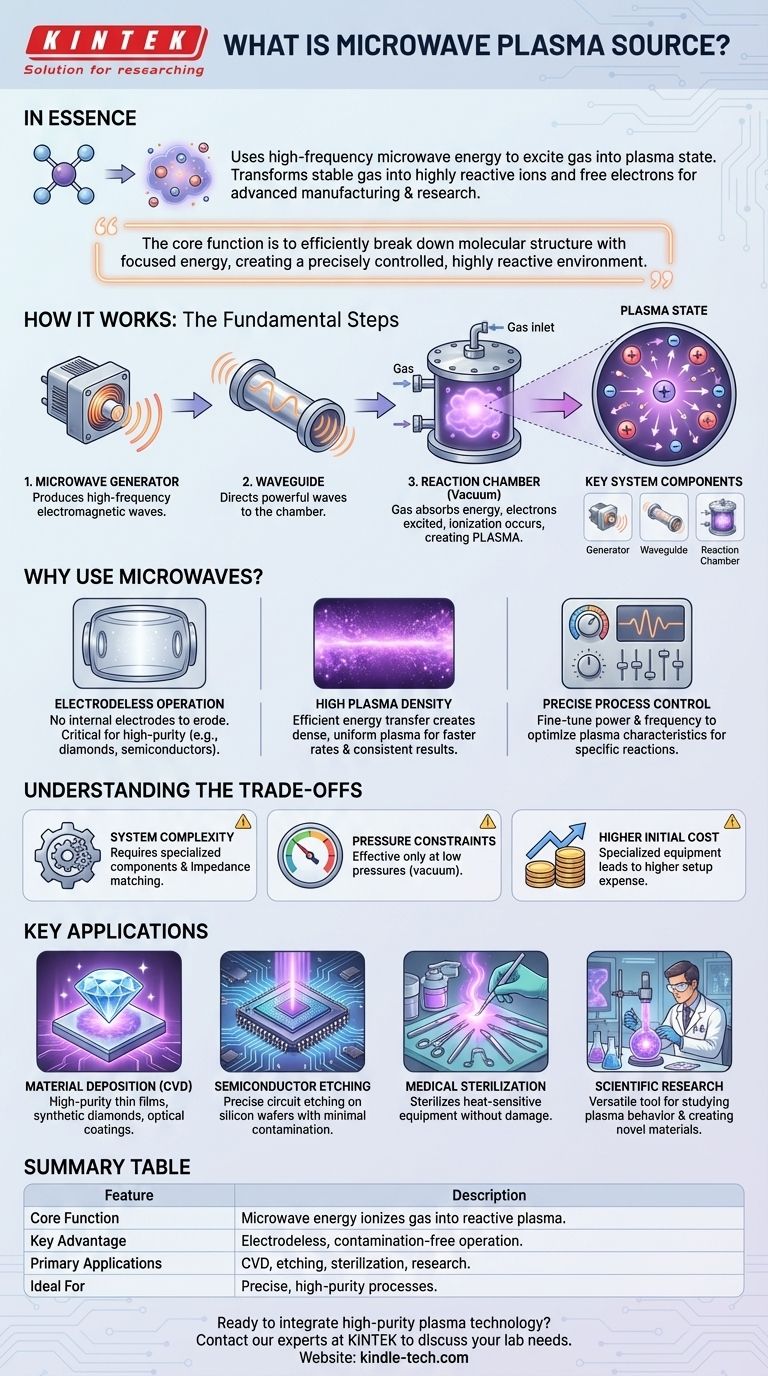In essence, a microwave plasma source is a device that uses high-frequency microwave energy to excite a gas into its plasma state. This process transforms a stable gas into a highly reactive cloud of ions and free electrons, which can then be used to drive chemical reactions or modify material surfaces for advanced manufacturing and scientific research, such as growing synthetic diamonds.
The core function of a microwave plasma source is not simply to heat a gas, but to efficiently break down its molecular structure with focused energy. This creates a precisely controlled, highly reactive environment that enables processes impossible under normal conditions.

How a Microwave Plasma Source Works
To understand its function, we can break down the process into its fundamental steps. It's a highly controlled application of energy to matter.
The Role of Microwave Energy
A microwave plasma source begins with a generator, often a magnetron, which produces high-frequency electromagnetic waves. These are the same type of waves used in a kitchen microwave, but they are far more powerful and are carefully directed through a component called a waveguide.
Gas Excitation and Ionization
This focused microwave energy is channeled into a sealed chamber, typically held under a vacuum, containing a specific gas or mixture of gases (like hydrogen and methane in the case of diamond growth). The energy from the microwaves is absorbed by the gas molecules and atoms.
This absorption of energy excites the electrons orbiting the gas atoms, giving them enough energy to escape the atom's pull entirely. This process is called ionization.
Creating the Plasma State
The result is a mixture of positively charged ions (atoms that have lost electrons) and a sea of free, high-energy electrons. This energized, ionized gas is plasma—often called the fourth state of matter. This plasma is extremely reactive chemically.
Key System Components
A typical system consists of three main parts:
- A microwave generator to create the energy.
- A waveguide to transmit that energy efficiently.
- A reaction chamber where the gas is introduced and converted into plasma.
Why Use Microwaves for Plasma?
Other methods can generate plasma, but the microwave approach offers distinct advantages that make it essential for high-purity, high-performance applications.
Electrodeless Operation
Unlike many direct current (DC) plasma systems, microwave sources are electrodeless. The energy is coupled into the gas via electromagnetic fields, so there are no metal electrodes inside the chamber that can erode and contaminate the process. This is critical for semiconductor manufacturing and creating pure materials like synthetic diamonds.
High Plasma Density
Microwave sources are highly efficient at transferring energy to the gas, allowing them to create a dense, uniform plasma. This high density of reactive species leads to faster deposition or etching rates and more consistent results across a surface.
Precise Process Control
The power and frequency of the microwaves can be controlled with extreme precision. This allows operators to fine-tune the plasma's characteristics (like temperature and density) to optimize the specific chemical reaction they need to perform.
Understanding the Trade-offs
While powerful, this technology is not a universal solution. Its advantages come with specific requirements and limitations.
System Complexity
Microwave plasma systems are more complex than simpler plasma generation methods. They require specialized components for generating and guiding the microwaves, as well as impedance matching systems to ensure the energy is transferred efficiently to the gas.
Operating Pressure Constraints
This technology operates most effectively within a specific range of low pressures (a vacuum). It is not well-suited for applications that require plasma generation at atmospheric pressure or in very high-vacuum environments.
Higher Initial Cost
The specialized components, including the microwave generator and precision vacuum chamber, result in a higher initial equipment cost compared to some alternative plasma sources.
Key Applications: Where This Technology is Used
The unique properties of microwave-generated plasma make it a critical tool for several cutting-edge industries.
- For material deposition: Its primary use is in Chemical Vapor Deposition (CVD), where the reactive plasma deposits high-purity thin films, such as creating flawless synthetic diamonds or specialized optical coatings.
- For semiconductor etching: In chip manufacturing, the plasma is used to precisely etch microscopic circuits onto silicon wafers with a high degree of control and minimal contamination.
- For sterilization of medical equipment: The energetic plasma can effectively sterilize heat-sensitive medical instruments without the damage caused by high-temperature autoclaves.
- For fundamental scientific research: It serves as a versatile and clean tool for physicists and material scientists studying plasma behavior and creating novel materials.
Ultimately, a microwave plasma source is a foundational technology for creating precisely engineered, highly reactive environments that drive modern materials science and high-tech manufacturing.
Summary Table:
| Feature | Description |
|---|---|
| Core Function | Uses microwave energy to ionize gas, creating a reactive plasma. |
| Key Advantage | Electrodeless operation prevents contamination for high-purity results. |
| Primary Applications | Chemical Vapor Deposition (CVD), semiconductor etching, sterilization. |
| Ideal For | Processes requiring precise control and high-purity material synthesis. |
Ready to integrate high-purity plasma technology into your lab?
KINTEK specializes in advanced lab equipment, including plasma systems for cutting-edge research and manufacturing. Our expertise can help you achieve precise, contamination-free results in material deposition and surface modification.
Contact our experts today to discuss how our solutions can meet your specific laboratory needs.
Visual Guide

Related Products
- Cylindrical Resonator MPCVD Machine System Reactor for Microwave Plasma Chemical Vapor Deposition and Lab Diamond Growth
- Microwave Plasma Chemical Vapor Deposition MPCVD Machine System Reactor for Lab and Diamond Growth
- Chemical Vapor Deposition CVD Equipment System Chamber Slide PECVD Tube Furnace with Liquid Gasifier PECVD Machine
- Customer Made Versatile CVD Tube Furnace Chemical Vapor Deposition Chamber System Equipment
- RF PECVD System Radio Frequency Plasma-Enhanced Chemical Vapor Deposition RF PECVD
People Also Ask
- How do lab-grown diamonds compare to natural diamonds? Uncover the Truth About Origin, Price, and Value
- What is a microwave plasma reactor? Unlock Precision Synthesis of High-Performance Materials
- How to start a lab grown diamond business? Choose the Right Model for Success
- What is MPCVD method? A Guide to High-Purity Diamond Synthesis
- Which lab grown diamond process is best? Focus on Quality, Not the Method



















